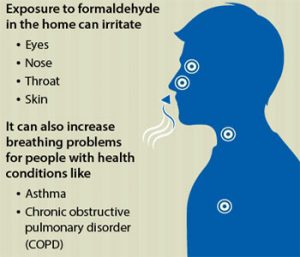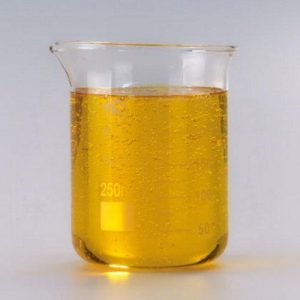Formaldehyde is a useful chemical that is used in many manufacturing processes and in day-to-day life. It also poses a danger because of its toxic and carcinogenic properties and as such should be handled safely. Formaldehyde is a volatile organic compound (VOC) with a strong and distinctive odor that can be found in a clear liquid form or gas vapor. Formaldehyde has several uses: as an intermediate in the production of resins and industrial chemicals, as a disinfectant (bactericide), as a preservative or embalming agent, as a final wash in photography film, and as a component in the manufacture or treatment of many consumer products.
Formaldehyde Exposure
Because of its common use, formaldehyde pollution must be proactively guarded against. For example, it is not uncommon for formaldehyde fumes to enter ones indoor air from various materials or finishes from products treated or manufactured with formaldehyde such as manufactured woods, carpets, molded plastics, clothing, and various other building products and textiles. In buildings where vehicles park, such as fire stations and bus depots, a build-up in the concentration of formaldehyde fumes can occur, which would contribute to poor air quality and potentially create a hazardous environment.
Formaldehyde Exposure Health Effects

How can formaldehyde exposure affect you in your home? (Source)
Studies have shown that exposure to formaldehyde can result in many respiratory illnesses including asthma-like symptoms Click Here for information on Occupational Asthma). Researchers have also linked low levels of formaldehyde exposure to triggering health issues that affect one’s eyes, nose, skin, and throat. The chemical has been identified by OSHA as a “cancer-causing” substance.
Formaldehyde Exposure Limits
According to the Occupational Safety and Health Administration (OSHA), the current permissible exposure limit (PEL) for formaldehyde is 0.75 part of formaldehyde per million parts of air (ppm) as a time-weighted average over 8 hours. The short-term exposure limit (STEL) is 2 ppm for any 15-minute sampling period. Engineering controls should be taken if your activity level is 0.5 ppm. To determine this you will need to conduct sampling. It is recommended to use a Certified Industrial Hygienist to conduct this testing.
Formaldehyde Exposure Control Solutions

From left to right: Model 300 Portable Fume Extractor removing formaldehyde fumes from hair straightening procedures; Model 200 Winged Sentry with Lidextracts chemical fumes before entering the operator’s breathing zone; 40″ Wide Ductless Fume Hood contains fumes within the hood, filtering them out before releasing the clean air back into the surrounding room.
Sentry Air Systems offers a wide variety of solutions for removal of formaldehyde fumes. The specialty blended activated carbon filters in our units reduce exposure to the chemical while providing clean, filtered air in the workspace. In fact, this high filtration efficiency of the specialty blend is demonstrated in the filter efficiency report on our website. The report confirms that the Sentry Air Systems units absorb the hazardous formaldehyde vapors, reduce their concentration, and recycle the air back into the room. This approach is not only cost-effective, but also “Green”: ductless systems don’t allow harmful particulate to be released into the atmosphere like it would be with a ducted system that delivers contaminated air outdoors. If you believe that you are being exposed to formaldehyde fumes or work with a process that utilizes formaldehyde, contact an industrial hygienist or seek the advice of a medical professional.
Protect your employees from formaldehyde exposure by contacting an application specialist today!
Call us today at 1-800-799-4609
Or visit our Formaldehyde Fume Extraction webpage on our main website.
Helpful Links
Formaldehyde – CDC/NIOSH http://www.cdc.gov/niosh/docs/81-123/pdfs/0293.pdf
OSHA Annotated PELS – Table Z-1https://www.osha.gov/dsg/annotated-pels/tablez-1.html
Information on Formaldehyde Fumes in Brazilian Keratin Treatment: https://www.sentryair.com/blog/formaldehyde-fumes/brazilian-keratin-treatment-health-risks-and-a-safety-recommendation/

 Made in the USA
Made in the USA
